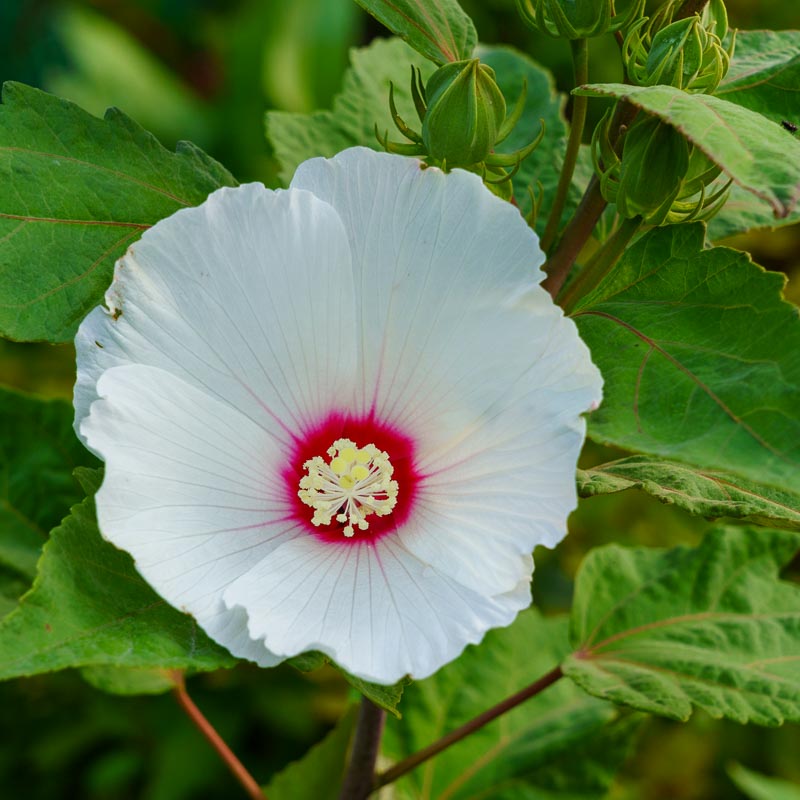Hardy Hibiscus
| Attribute | Value |
|---|---|
| Common Name | Hardy Hibiscus |
| Botanical Name | Hibiscus moscheutos L. |
| Mature Size | 3 to 8’ tall, 2’ wide |
| Sun Exposure | Part Sun, Sun |
| Soil Type | Average, organically rich |
| Soil pH | Neutral to slightly acidic |
| Bloom Time | Summer |
| Flower Color | White or pink |
| Care | Hardy hibiscus plants are surprisingly easy to care for considering their bountiful, delicate blooms—if they receive enough sunlight and water. They do well as container-grown plants, too, allowing you the opportunity to bring the plant indoors for the winter season if you live in a cold climate. Repot container-grown hibiscus into a larger pot every two to three years. |
| Soil | Hardy hibiscus are wetland plants, and therefore are the ideal specimens for moist areas on your property where it might be difficult to grow other plants that don't require as much moisture. Hardy hibiscus also grows well when planted around water features and ponds. Hardy hibiscus plants require organically rich soils—if the soil in your landscape is not rich with organic material, amend the planting area with organic compost before planting. |
| Water | If you can't locate hardy hibiscus plants in a moist spot in your landscape, make sure to keep the plants adequately watered—but don't overdo it. A hardy hibiscus is typically thirsty and needs a deep watering of at least 1 to 2 inches of water per week and needs to be watered almost everyday. A small plant with fewer leaves needs less water than a large, leafy plant. A good indicator that your plant needs watering is when an inch down into the soil is dry. |
| Temperature and Humidity | Hibiscus plants flower best in temperatures that range from 65 degrees Fahrenheit to 75 degrees Fahrenheit. Bring plants indoors before temperatures dip to 32 degrees Fahrenheit, but be mindful that low humidity can dry them out quickly. If you bring your hardy hibiscus indoors for the winter, you'll need to mist the leaves daily or place each pot on a pebble tray filled with water. As the water evaporates, the humidity will rise around the plant. A small space humidifier will also raise humidity levels in your home. |
| Fertilizer | Mom - “I fertilize in early spring with chick poop that I use on the rhubarb, just cuz it is in same garden.” Hardy hibiscus plants need plenty of nutrients and regular feeding. Feed your plant with a diluted liquid fertilizer once a week or a slow-release fertilizer three times a year, including early spring, after the first round of blooming, and mid-summer. |
| Pruning | Because this plant dies to the ground in winter, you can prune it down to the ground in fall or in spring before new growth emerges. The root system will survive the winter, and new growth will emerge from the root system. |
| Overwintering | Mom - “I collect seeds in fall and then when leaves die and look ratty I cut stalks to the ground. They are very late to shown growth in spring.” If you live with mild temperatures year-round, then your hardy hibiscus will thrive throughout the year, too. But if you live in an area where winter temps dip below freezing, you will need to protect your plants. When overwintering hardy hibiscus that's planted in the ground, wrap it in a heavy cloth (burlap) or tarp. The material will need to be able to stand up to freezing, frosty conditions. If your hardy hibiscus is potted outdoors, you can bring it indoors but it will need to stay in temperatures of about 55 degrees Fahrenheit plus about three to four hours of direct full sun a day to survive. |
| Source | https://www.thespruce.com/hardy-hibiscus-plants-2132719 |

